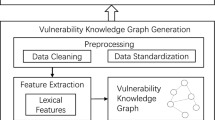Abstract
Insider threat has emerged as the most destructive security threat due to its secrecy and great destructiveness to the core assets. It is very important to detect malicious insiders for protecting the security of enterprises and organizations. Existing detection methods seldom consider correlative information between users and can not learn the extracted features effectively. To address the aforementioned issues, we present CapsITD, a novel user-level insider threat detection method. CapsITD constructs a homogeneous graph that contains the correlative information from users’ authentication logs and then employs a graph embedding technique to embed the graph into low-dimensional vectors as structural features. We also design an anomaly detection model using capsule neural network for CapsITD to learn extracted features and identify malicious insiders. Comprehensive experimental results on the CERT dataset clearly demonstrate CapsITD’s effectiveness.
Access this chapter
Tax calculation will be finalised at checkout
Purchases are for personal use only
Similar content being viewed by others
References
2020 Securonix Insider Threat Report. https://www.securonix.com/resources/2020-insider-threat-report/. (Accessed 29 Dec 2021)
2021 Insider threat report. https://gurucul.com/2021-insider-threat-report. (Accessed 29 Dec 2021)
Le, D.C., Zincir-Heywood, A.N.: Evaluating insider threat detection workflow using supervised and unsupervised learning. In: 2018 IEEE Security and Privacy Workshops (SPW), pp. 270–275. IEEE (2018)
Jiang, J., et al.: Anomaly detection with graph convolutional networks for insider threat and fraud detection. In: MILCOM 2019–2019 IEEE Military Communications Conference (MILCOM), pp. 109–114. IEEE (2019)
Gayathri, R., Sajjanhar, A., Xiang, Y.: Image-based feature representation for insider threat classification. Appl. Sci. 10(14), 4945 (2020)
Liu, L., De Vel, O., Han, Q.L., Zhang, J., Xiang, Y.: Detecting and preventing cyber insider threats: A survey. IEEE Commun. Surv. Tutorials 20(2), 1397–1417 (2018)
Nguyen, N., Reiher, P., Kuenning, G.H.: Detecting insider threats by monitoring system call activity. In: IEEE Systems, Man and Cybernetics Society Information Assurance Workshop, vol. 2003, pp. 45–52. IEEE (2003)
Wei, R., Cai, L., Yu, A., Meng, D.: Age: authentication graph embedding for detecting anomalous login activities. In: Zhou, J., Luo, X., Shen, Q., Xu, Z. (eds.) ICICS 2019. LNCS, vol. 11999, pp. 341–356. Springer, Cham (2020). https://doi.org/10.1007/978-3-030-41579-2_20
Bowman, B., Laprade, C., Ji, Y., Huang, H.H.: Detecting lateral movement in enterprise computer networks with unsupervised graph ai. In: 23rd International Symposium on Research in Attacks, Intrusions and Defenses (RAID 2020), pp. 257–268 (2020)
Hinton, G.E., Krizhevsky, A., Wang, S.D.: Transforming auto-encoders. In: Honkela, T., Duch, W., Girolami, M., Kaski, S. (eds.) ICANN 2011. LNCS, vol. 6791, pp. 44–51. Springer, Heidelberg (2011). https://doi.org/10.1007/978-3-642-21735-7_6
Zhang, X., Yin, S.: Intrusion detection model of random attention capsule network based on variable fusion. J. Commun. 41(11), 160 (2020)
Li, X.: Anomaly Detection Based on Disentangled Representation Learning. Ph.D. thesis, Université d’Ottawa/University of Ottawa (2020)
Jiang, J., et al.: Prediction and detection of malicious insiders’ motivation based on sentiment profile on webpages and emails. In: MILCOM 2018–2018 IEEE Military Communications Conference (MILCOM), pp. 1–6. IEEE (2018)
Chattopadhyay, P., Wang, L., Tan, Y.P.: Scenario-based insider threat detection from cyber activities. IEEE Trans. Comput. Soc. Syst. 5(3), 660–675 (2018)
Glasser, J., Lindauer, B.: Bridging the gap: A pragmatic approach to generating insider threat data. In: 2013 IEEE Security and Privacy Workshops, pp. 98–104. IEEE (2013)
Acknowledgment
This work is supported by National Key Research and Development Program of China (No.2021YFF0307203, No.2019QY1300), and NSFC (No. 61902376), Youth Innovation Promotion Association CAS (No.2021156), the Strategic Priority Research Program of Chinese Academy of Sciences (No. XDC02040100). This work is also supported by the Program of Key Laboratory of Network Assessment Technology, the Chinese Academy of Sciences, Program of Beijing Key Laboratory of Network Security and Protection Technology.
Author information
Authors and Affiliations
Corresponding author
Editor information
Editors and Affiliations
Rights and permissions
Copyright information
© 2023 ICST Institute for Computer Sciences, Social Informatics and Telecommunications Engineering
About this paper
Cite this paper
Xiao, H. et al. (2023). CapsITD: Malicious Insider Threat Detection Based on Capsule Neural Network. In: Li, F., Liang, K., Lin, Z., Katsikas, S.K. (eds) Security and Privacy in Communication Networks. SecureComm 2022. Lecture Notes of the Institute for Computer Sciences, Social Informatics and Telecommunications Engineering, vol 462. Springer, Cham. https://doi.org/10.1007/978-3-031-25538-0_4
Download citation
DOI: https://doi.org/10.1007/978-3-031-25538-0_4
Published:
Publisher Name: Springer, Cham
Print ISBN: 978-3-031-25537-3
Online ISBN: 978-3-031-25538-0
eBook Packages: Computer ScienceComputer Science (R0)




